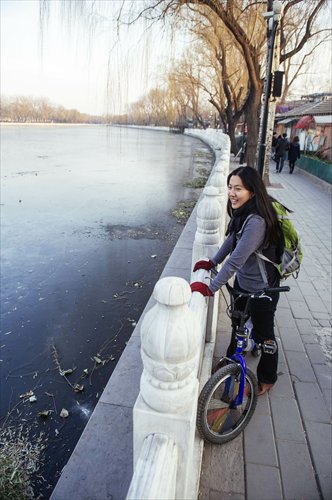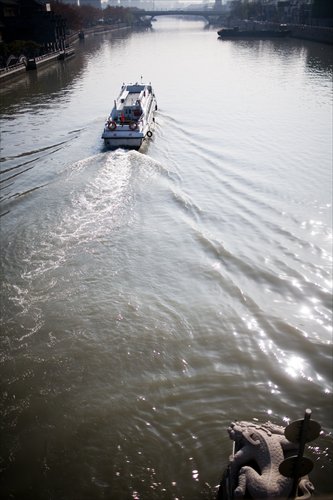

The Grand Canal, which runs from Hangzhou, Zhejiang Province to Beijing, through Shichahai Lake, is the longest manmade waterway in the world. Photo: Li Hao/GT

A boat on a section of the canal in Hangzhou. Photo: Li Hao/GT
A nostalgic way to experience China's ancient man-made waterway
Rather than joining the thronging mobs that overran China's popular tourist spots during this year's National Day holidays, Zhang Shuang, 27, got on his bicycle and took to the dusty countryside roads that trace the 2,500-year-old Grand Canal.
Zhang, a kindergarten teacher who lives in Nanjing, Jiangsu Province, had previously ridden along the portion of the canal from Huaian, Jiangsu Province to Beijing. In October, he completed his journey along the ancient waterway, riding south towards Hangzhou, Zhejiang Province.
"Nanjing and Beijing, which during different dynasties have both served as the capital of the country, are linked by the canal," said Zhang. "It traverses time and space, linking together the country and its culture."
The longest man-made waterway in the world, the Grand Canal runs 1,734 kilometers from Beijing to Hangzhou. Construction on the monumental waterway began in 486 BC, and in the centuries following, it has acted as a conduit for transporting grain from China's fertile south to the arid north, at the same time unifying China's disparate terrains economically and culturally. Placed onto UNESCO's World Heritage list in June, the Grand Canal was described by the committee as "the world's largest and most extensive civil engineering project prior to the Industrial Revolution."
Today, parts of the canal still serve its initial purpose as an arterial for transport and commerce, while others lie neglected in various states of disrepair. In the wake of its inscription onto the UNESCO list, however, tourism has noticeably picked up. The Hangzhou Daily reported that the part of the canal in Zhejiang Province was visited by more than 1 million people during the National Day holidays, an increase of 14.5 percent over the previous year.
As Chinese people's tourism habits continue to change and become more varied, some people, like Zhang, are choosing to trace the route by bicycle.
Having a grand old time
During this year's Canal Greenway Cycling Festival in May, as many as 15,000 participants cycled along a portion of the Grand Canal running through Beijing's Tongzhou district, according to people.com.cn.
"It changes your life," said Qi Xin, a 51-year-old journalist and cultural heritage expert who frequently cycles along different parts of the Grand Canal. "The beauty of [walking or cycling] along the canal will captivate your entire heart and soul."
Qi travels around various universities in China giving lectures about the preservation of cultural heritage in the country. Since 2009, he has devoted much of his efforts to the Grand Canal, and in particular to promoting a land-based route, which traces the ancient waterway's entire length and can be traveled by foot or bicycle. Known as the "Grand Trek," Qi has set up a Sina Weibo account with detailed information about the route. The impetus for doing the Grand Trek, said Qi, was that one could truly experience the history of the ancient waterway, rather than simply seeing mere "attractions." "The experience of the trek is much richer than just visiting one spot [along the Grand Canal]," said Qi. "People who just visit a couple of designated places by car and then quickly leave only see relics, but not the trail itself, which is where the real history is. What is unique, from a cultural heritage perspective, are the small villages that trace the river, the remote country roads."
Zhang agreed with Qi's assessment. When asked about the highlights of his bicycle ride tracing the historic canal, he mentioned simple quotidian scenes of nature and everyday life.
Zhang said that one of his favorite memories was while cycling along a section of the Grand Canal that opens out to the Weishan Lake, on the border of the Shandong and Hebei provinces.
"On one side is are bustling barges floating on the surface of the lake, on the other side, bright sunlight and clusters of trees," said Zhang.
Preserving the Grand Canal
The importance of cycling or hiking along the Grand Canal, said Qi, was that it allowed people to understand and preserve it as part of the fabric of China's living history that continues through to today, rather than as a mere artifact of the past.
He said that the Grand Trek stood opposed to the idea of transforming the Grand Canal into a series of tourist spots."More money should be spent in preserving the integrity of the canal, rather than constructing [tourist attractions along the canal]," said Qi.
Qi said that the idea behind the Grand Trek project was to offer a different way for people to engage with China's cultural heritage that could also be applied to other historical sites, such as the ancient Shu Roads, a system of 2,000-year-old mountain paths joining the Sichuan Province and Shaanxi Province. Only by taking one's time, Qi suggested, could one appreciate the history and culture of a site, rather than seeing it as a mere tourist attraction. "Tourism is changing from a visual experience to a value experience," said Qi.
Zhang Hailei, a 25-year-old graduate student in media and communication who has long been fascinated by the Grand Canal, has experienced first-hand what Qi meant by a "value experience" in her explorations of the ancient waterway on bicycle. She said the process of making her way along the canal gave her a sense of the intimacy that exists between its past and its present, through people whose lives are still linked to it.
"At first I thought the canal was just like a river with ancient houses on both sides all the way, clear water and cargo ships going back and forth, but when I actually rode my bicycle along it, I saw small ditches, and some of the parts were gone," said Zhang Hailei, who has cycled several times along the Beijing section of the canal.
"Originally I thought cycling the Grand Canal was just about riding a bicycle along a river, but in the process of doing it, I discovered that it's actually about the different cultural relics and sites along the route, learning about them and realizing how they are linked together," said Zhang Hailei. "I would have never known that the places we passed by used to be barns or docks in ancient China if it weren't for cycling [along the canal]. It was an amazing experience."
Smaller grandeurs
As many will be unable to travel the entire length of the Grand Canal in a single journey, Qi suggested them dividing the route into smaller sections, with cyclists covering 50 to 100 kilometers each time.
He advised those interested in exploring the historic waterway to plan fastidiously beforehand. "The routes can be complicated, and it's possible that one will encounter many practical problems, like having your route blocked by a factory right in the middle of road, or not having a bridge to cross the river in front of you," said Qi.
He also encouraged people to have a sense of spontaneity and flexibility in creating their own route. They should explore a route which links historical sites related to the canal that they are interested in, even if it meant deviating from the waterway.
One shorter route Qi recommended for Beijing locals is known as the Guo Shoujing Trek, named after the Yuan Dynasty (1279-1368) scholar who led the construction of the Beijing section of the canal.
The route starts from Guomao, traces along the Tonghui River to Jianguomen, before following the old city walls around the Forbidden City, winding through the hutong in Xicheng district, before arriving at Guo Shoujing Temple in Jishuitan area.
"From this trek, you will be able to savor the important historical events, the people and the culture of the Grand Canal. It links the historical, economic and human elements together," said Qi. "It makes you think about how the canal has brought 800 years of prosperity to Beijing."
Copyright ©1999-2018
Chinanews.com. All rights reserved.
Reproduction in whole or in part without permission is prohibited.